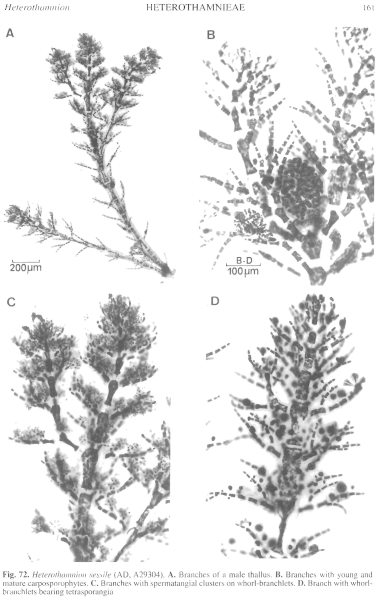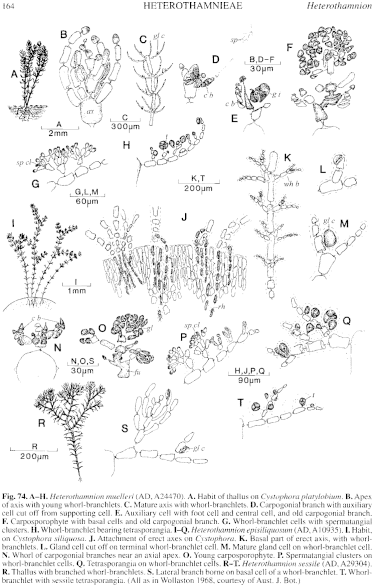|
|
|
|
|
|||||||||||
|
Electronic Flora of South Australia Species Fact Sheet
Phylum Rhodophyta – Order Ceramiales – Family Ceramiaceae – Tribe Heterothamnieae
Selected citations: Athanasiadis 1996: 188, fig. 98.
Thallus (Fig. 72A) in small tufts 2–5 mm high, with several clumped axes from the base, each axial cell bearing 4 whorl-branchlets (1–3 on lower axial cells), curved slightly upwards and branched (Fig. 72A, 74R). Attachment by basal rhizoids penetrating the host, with new axes arising from upper cells of the rhizoids; epiphytic on Cystophora platylobium. Structure. Apical cells 4–6 µm in diameter and L/D 1–1.5, enlarging rapidly to axial cells 80–100 µm in diameter and L/D 1.5–2.5, tapering and with shorter cells towards the base. Whorl-branchlets (Fig. 72A) developing close to and surrounding the apices, 200–320 µm and 5–10 cells long with 3–6 alternate branches (from the basal or mid cells) each 1–5 cells long, on the central axes, 100–200 µm and 4–6 cells long, simple or once branched, on lower axes; basal cells slightly longer than next upper cell, 25–37 µm in diameter and L/D 1.5–2, tapering to terminal cells 10–12 µm in diameter and L/D 1–1.5, with rounded ends; gland cells occur on the lower to upper cells of whorl-branchlets, sessile, ovoid, 16–20 µm in diameter, touching only the bearing cell. Lateral branches arise on the basal cell of whorl-branchlets (Fig. 74S), frequent and 1–4 axial cells apart on the upper thallus. Cells uninucleate; rhodoplasts discoid to elongate.
Reproduction: Gametophytes dioecious. Carpogonial branches occur on the basal cells of short, 2-celled branches on axial cells close to apices. Post-fertilization development as in H. muelleri, involving a tubular connecting cell and the auxiliary cell dividing to a foot cell and upper cell which produces a terminal and 1–2 lateral, rounded, gonimolobes 80–120 µm across with chains of carposporangia 8–10 µm in diameter; whorl-branchlets and lateral branches from cells below loosely surround the carposporophyte (Fig. 72B). Spermatangia are borne on branched clusters of cells (Fig. 72C), adaxially on successive lower cells of whorl-branchlets.
Tetrasporangia (Figs 72D, 74T) occur on successive lower cells of whorl-branchlets, sessile, subspherical, 25–35 µm in diameter, tetrahedrally divided.
Type from Victor Harbor, S. Aust. on Cystophora platylobium, drift ( Wollaston, 2.x.1963); holotype in AD, A29304.
Selected specimens: Seal Bay, Kangaroo I., S. Aust., on Cystophora platylohium, drift (Womersley, 29.x.1966; AD, A31059).
Taxonomic notes: Known only from the type and Seal Bay, Kangaroo I., S. Australia.
H. sessile, which occurs on the same host as H. muelleri, differs from the latter in having more branched whorl-branchlets and sessile tetrasporangia.
References:
ATHANASIADIS, A. (1996). Morphology and classification of the Ceramioideae (Rhodophyta) based on phylogenetic principles. Opera Botanica No. 128, pp. 1–216.
WOLLASTON, E.M. (1968).Morphology and taxonomy of southern Australian genera of Crouanieae Schmitz (Ceramiaceae, Rhodophyta). Aust. J. Bot. 16, 217–417.
The Marine Benthic Flora of Southern Australia Part IIIC complete list of references.
Publication:
Womersley, H.B.S. (24 December, 1998)
The Marine Benthic Flora of Southern Australia
Rhodophyta. Part IIIC. Ceramiales – Ceramiaceae, Dasyaceae
©State Herbarium of South Australia, Government of South Australia
Illustrations in Womersley Part IIIA, 1998: FIGS 72, 74 R–T.

Figure 72 enlarge
Fig. 72. Heterothamnion sessile (AD, A29304). A. Branches of a male thallus. B. Branches with young and mature carposporophytes. C. Branches with spermatangial clusters on whorl-branchlets. D. Branch with whorl-branchlets bearing tetrasporangia

Figure 74 enlarge
Fig. 74. A–H. Heterothamnion muelleri (AD, A24470). A. Habit of thall us on Cystophora platylobium. B. Apex of axis with young whorl-branchlets. C. Mature axis with whorl-branchlets. D. Carpogonial branch with auxiliary cell cut off from supporting cell. E. Auxiliary cell with foot cell and central cell, and old carpogonial branch. F. Carposporophyte with basal cells and old carpogonial branch. G. Whorl-branchlet cells with spermatangial clusters. H. Whorl-branchlet bearing tetrasporangia. I–Q. Heterothamnion episiliquosum (AD, A10935). I. Habit, on Cystophora siliquosa. J. Attachment of erect axes on Cystophora. K. Basal part of erect axis, with whorl-branchlets. L. Gland cell cut off on terminal whorl-branchlet cell. M. Mature gland cell on whorl-branchlet cell. N. Whorl of carpogonial branches near an axial apex. O. Young carposporophyte. P. Spermatangial clusters on whorl-branchlet cells. Q. Tetrasporangia on whorl-branchlet cells. R–T. Heterothamnion sessile (AD, A29304). R. Thallus with branched whorl-branchlets. S. Lateral branch borne on basal cell of a whorl-branchlet. T. Whorl-branchlet with sessile tetrasporangia. (All as in Wollaston 1968, courtesy of Aust. J. Bot.)

|
Email Contact: State Herbarium of South Australia |

|